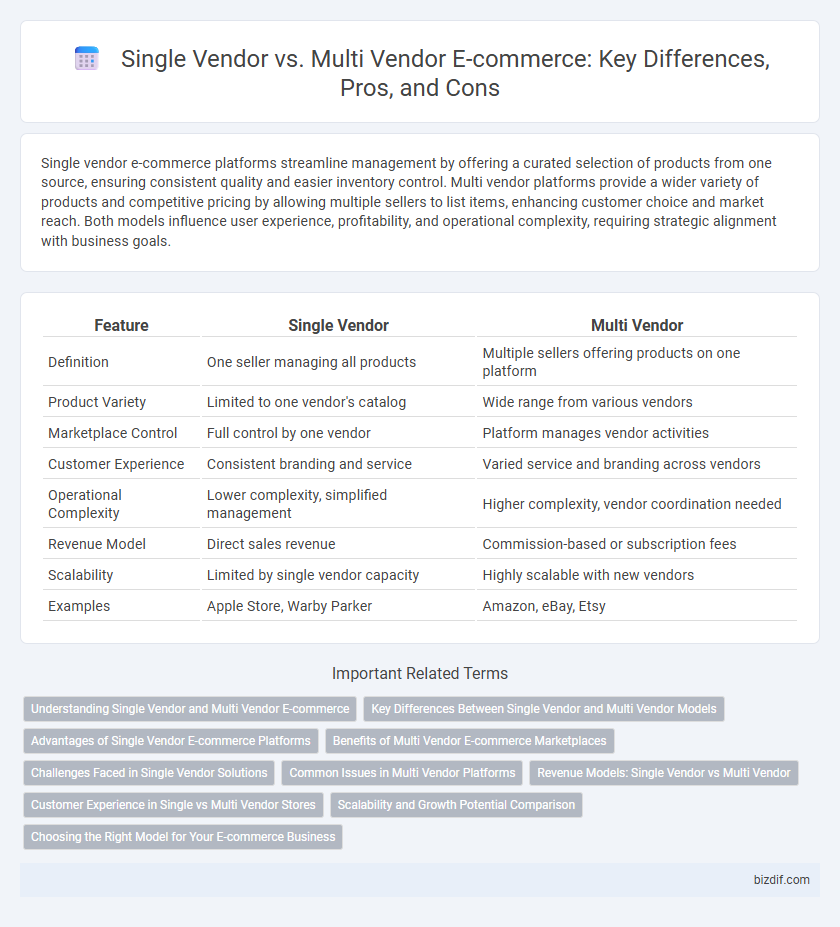Single vendor e-commerce platforms streamline management by offering a curated selection of products from one source, ensuring consistent quality and easier inventory control. Multi vendor platforms provide a wider variety of products and competitive pricing by allowing multiple sellers to list items, enhancing customer choice and market reach. Both models influence user experience, profitability, and operational complexity, requiring strategic alignment with business goals.
Table of Comparison
| Feature | Single Vendor | Multi Vendor |
|---|---|---|
| Definition | One seller managing all products | Multiple sellers offering products on one platform |
| Product Variety | Limited to one vendor's catalog | Wide range from various vendors |
| Marketplace Control | Full control by one vendor | Platform manages vendor activities |
| Customer Experience | Consistent branding and service | Varied service and branding across vendors |
| Operational Complexity | Lower complexity, simplified management | Higher complexity, vendor coordination needed |
| Revenue Model | Direct sales revenue | Commission-based or subscription fees |
| Scalability | Limited by single vendor capacity | Highly scalable with new vendors |
| Examples | Apple Store, Warby Parker | Amazon, eBay, Etsy |
Understanding Single Vendor and Multi Vendor E-commerce
Single vendor e-commerce platforms host products from one seller, providing streamlined inventory management and consistent brand experience, which benefits businesses seeking full control over sales and customer interactions. Multi vendor e-commerce platforms aggregate offerings from various sellers, expanding product variety and competitive pricing, while requiring robust systems to handle diverse inventory, payment gateways, and dispute resolution. Understanding these models helps businesses choose the optimal platform based on scalability, operational complexity, and target market dynamics.
Key Differences Between Single Vendor and Multi Vendor Models
Single vendor e-commerce platforms operate with one seller managing all product listings, inventory, and customer service, ensuring full control and consistent branding. Multi vendor platforms host multiple independent sellers, offering diverse product ranges and competitive pricing but requiring complex commission, dispute resolution, and logistics management systems. Key differences include inventory control centralized in single vendor models versus distributed across sellers in multi vendor setups, affecting scalability and customer experience management.
Advantages of Single Vendor E-commerce Platforms
Single vendor e-commerce platforms streamline inventory management, reducing complexities related to coordination and quality control. Centralized control enables consistent brand messaging and personalized customer experiences, which can enhance loyalty and trust. Operating on a single vendor model often leads to faster decision-making and smoother implementation of updates or changes, improving overall operational efficiency.
Benefits of Multi Vendor E-commerce Marketplaces
Multi vendor e-commerce marketplaces expand product variety by allowing numerous sellers to list diverse items, enhancing consumer choice and satisfaction. They facilitate increased competition, which often drives competitive pricing and promotional offers, benefiting buyers with better deals. These platforms reduce operational costs for individual sellers by sharing infrastructure, payment processing, and marketing, enabling scalability and faster business growth.
Challenges Faced in Single Vendor Solutions
Single vendor e-commerce solutions often face challenges such as limited product variety and slower marketplace growth, which can restrict customer choice and reduce competitive pricing. Managing inventory and logistics complexity falls entirely on one vendor, leading to potential scalability issues and increased operational costs. Moreover, single vendor platforms may struggle with attracting diverse customer segments compared to multi-vendor marketplaces that offer extensive product ranges and competitive seller dynamics.
Common Issues in Multi Vendor Platforms
Multi vendor e-commerce platforms often face challenges such as inconsistent product quality, complex inventory management, and disputes over commission fees. Ensuring seamless integration between multiple sellers and maintaining uniform customer service standards can lead to operational inefficiencies. Fraud prevention and handling diverse return policies also require robust systems to maintain platform trustworthiness and user satisfaction.
Revenue Models: Single Vendor vs Multi Vendor
Single vendor e-commerce platforms generate revenue primarily through direct sales and controlled pricing, ensuring consistent profit margins from inventory owned and managed by the business. Multi-vendor marketplaces leverage diverse revenue streams, including commission fees, subscription plans, and listing charges from multiple sellers, driving higher overall transaction volumes. The scalability of multi-vendor models often results in increased revenue potential, while single vendor platforms benefit from streamlined operations and brand consistency.
Customer Experience in Single vs Multi Vendor Stores
Single vendor stores offer a streamlined customer experience with consistent product quality and uniform brand policies, reducing confusion during the shopping process. Multi vendor platforms provide a wider product variety and competitive pricing but can result in inconsistent service levels and varied shipping times, impacting overall customer satisfaction. Customers often prefer single vendor stores for reliability and simplicity, while multi vendor marketplaces attract those seeking diverse options and deals.
Scalability and Growth Potential Comparison
Single vendor e-commerce platforms offer streamlined operations but often face limitations in scalability due to dependency on a single product source and inventory constraints. Multi-vendor marketplaces enable exponential growth by aggregating diverse sellers and product categories, facilitating wider customer reach and increased revenue streams. The scalability of multi-vendor models supports better adaptation to market demand fluctuations and accelerated business expansion through collaborative vendor ecosystems.
Choosing the Right Model for Your E-commerce Business
Selecting between a single vendor and multi vendor e-commerce model depends on factors such as product variety, inventory management, and customer reach. Single vendor platforms offer streamlined control and consistent branding, ideal for businesses focusing on niche markets or exclusive products. Multi vendor marketplaces provide diverse offerings and broader audiences, benefiting businesses aiming for rapid scale and extensive market penetration.
Single Vendor vs Multi Vendor Infographic

 bizdif.com
bizdif.com